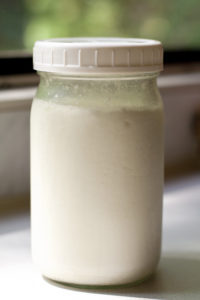The first food I ever tried fermenting was yogurt. I didn’t quite realize at the time that’s was what I was doing. I just read you could take some plain yogurt, mix it with milk, and leave it (in something warm no less) for 8 hours and it turned into more yogurt.
When I first tried it, pulling out my jars and seeing a whole textural transformation, I was fascinated. It was like a science experiment. After I tasted it and found the flavor to be just like store bought yogurt, I was hooked.
Now a couple years later, I understand culturing the milk into yogurt was same principle as fermenting vegetables (like sauerkraut) or making a ginger bug to use in ginger beer. Fermentation is one of the oldest forms of food preservation. With the invention of refrigeration it’s one we’ve gotten away from which is a shame because fermented foods have a lot of health benefits such as being enzyme rich, easily disgestible and full of probiotics.
There are many types of fermentation. One process is lacto-fermentation. Basically this is the process of creating an environment that allows “good” lactic acid bacteria, found in nearly everything, to convert natural sugars and starches into lactic acid. Lactic acid is a natural preservative that keeps bad bacteria from growing and allows good to flourish.
Though it still seems strange to most of us to leave jars out on a counter, fermentation is one of the safest ways of processing food. Some science has even suggested it is safer than raw vegetables which could have been exposed to pathogens such as E. coli. The lactic acid rich environment destroys these pathogens and toxins.
There are two paths to lacto-fermenting food. With raw vegetables, a simple salt brine keeps the bad bacteria from growing until the lactic acid bacteria can take over. This is the case with sauerkraut. When working with a food that has already been cooked, much of the lactic acid bacteria has been killed off so you need to introduce a starter culture to help it take back over. This is the case for yogurt and water kefir.
In the past months I’ve ventured out into more different foods to ferment. Same as the original batch of yogurt, I refer to them as my experiments. Sometimes they work out and are awesome. Sometimes they work out but the flavor not so much. I must have had the salt ratio completely wrong for my first batch of fermented pickles. Sometimes I can’t figure out the timing with changing temperatures to keep my milk kefir from separating. But it’s all part of learning and getting hands on experience to gain confidence with different foods.
Making Homemade Yogurt

Besides beer and wine, yogurt is probably the most popular fermented food Americans consume. Now there are tons and tons of methods out there for making homemade yogurt. I’m sharing what works for me and how I’ve simplified my practice to make it even easier.
What You Will Need:
- 2/3 cup of plain yogurt (this is your starter – I just use a plain store bought Greek Yogurt)
- a half gallon of milk (I use whole cow’s milk. You just want to avoid ultra pasteurized)
- 2 quart size mason jars (I’ve also used old peanut jars before, just so long as its clean)
- small glass bowl
- a pot that is large enough to fit your jars with a lid on it (I use our pressure cooker to act as this)
I pour the milk into my widest pot and start heating it. I cover the pot to help it warm up faster and stir periodically to avoid any milk sticking to the bottom. In the past I just heated it until it reached 190°F. However I read Melissa K. Norris‘s book, Handmade: The Modern Guide to Made-From-Scratch Living, and she keeps hers at 175° for 15 minutes to get a creamier yogurt so I do that instead now. Bonus: the milk doesn’t accidentally boil over anymore.
After it has heated for 15 minutes, I carefully pour the milk into each of my mason jars and a small amount in the little glass bowl. Separating it out helps the milk cool down faster. We don’t have air conditioning so in the summer I sometimes put my jars into a large pot filled with cool water to help as well.
Once the milk in the little bowl is down to 110°F to 115°F I mix in my starter yogurt. When the larger jars are cool enough, I split this mixture between the two of them. Sometimes as the milk cools a skin will form on top. I just skim this off before adding the yogurt starter.
After the starter is mixed into both jars, I cap them and place them into the large pot. I add the hottest water I can get out of my sink into the pot and place the lid on it. This keeps the milk warm enough so the starter can culture it. In the winter, I wrap a towel around the pot to keep the heat in.
I prefer mine to culture for about 8 hours. Then I just remove the jars, check to be sure I like the way the consistency looks, and move them to the fridge. The longer you let the yogurt culture, the thicker but also more sour it will get. I haven’t gone longer than 12 hours.
We eat our yogurt within 2 weeks.
Notes and Variations:
Some people leave the milk in the pot for the entire process – to cool and then culture. The jars are easier for me in terms of space and temperature control.
People go about keeping the culturing milk warm in lots of different ways. I’ve read that some leave it in the oven with the light on overnight. I’ve heard of people filling an ice chest with warm water.
You can strain the finished yogurt through a cheese cloth to get a thicker final product similar to Greek yogurt. Then you can use the whey as starter liquid for other ferments.
You can hold onto 2/3 cup of your new yogurt and use it as a starter if you’d like. Sometimes I do this for a few batches but my yogurt seems to get thinner and thinner with each batch. One day I want to buy a fancy heirloom starter to try out and see if those work better for continuous batches.
Resources I Find Useful:
The Art of Fermentation by Sandor Ellix Katz
Handmade: The Modern Guide to Made-From-Scratch Living by Melissa K. Norris – I also enjoy her Pioneering Today Podcast
Cultures for Health – they sell starter cultures and write an informative blog for learning how to use their products
What foods do you want to try making at home? Share your thoughts and ideas in the comments below.


